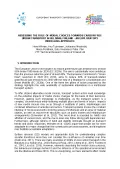-
Past ETC Papers

Browse, search and view papers from the past AET Conferences.
-
Members' Area

AET promotes networking and exchange of ideas, information and opportunities amongst members.
Conference Papers 2021
Online
ETC Conference Papers 2021
Assessing the contribution of modal choices towards carbon free urban transport in Helsinki, Finland - an exploratory modelling approach
Seminar
Day 2 (14 Sep 2021), Session 5, SYSTEM DYNAMICS APPLICATIONS FOR SUSTAINABLE URBAN MOBILITY, 13:00 - 15:00
Status
Accepted, documents submitted
Submitted by / Abstract owner
Anu Tuominen
Authors
Henri Wiman, VTT Technical Research Centre of Finland Ltd
Anu Tuominen, VTT Technical Research Centre of Finland Ltd
Johannes Mesimäki, VTT Technical Research Centre of Finland Ltd
Satu Innamaa, VTT Technical Research Centre of Finland Ltd
Peter Ylén, VTT Technical Research Centre of Finland Ltd
Merja Penttinen, VTT Technical Research Centre of Finland Ltd
Short abstract
The paper explores the potential of small, exploratory dynamic model in producing insight for policy-making on the impacts of modal shifts towards carbon free urban transport. The model is characterized by complexity and uncertain parameters.
Abstract
The European Union and many of its member states share a long-term target of carbon neutrality in their transport policies. The European Commission’s Green Deal, launched in 2020 targets to reduce transport-related greenhouse gas emissions by 90% by 2050 with a help of a Strategy for a Sustainable and Smart Mobility. One of the three key pillars of actions proposed by the strategy highlights wide availability of sustainable alternatives in a multimodal transport system.
To offer citizens alternative modal choices, transport system actors need, for the basis of their decisions, information and knowledge on the potential impacts of changes in present modal choices. Such knowledge production is challenging, as transport systems involve the constant interplay of micro-level events of individuals, material objects, and macro-level structures such as policy frames and infrastructures.
There is a vast amount of academic literature available on building scenarios for low carbon transport futures (e.g. Soria-Lara et al. 2021, Banister and Hickman 2013, Tuominen et al. 2014). The approaches address modal choice in a variety of ways, but they generally lack a quantified or otherwise intricately examined personal modal choice process, which could illustrate the micro-level events of groups or individuals. There are also many examples of System Dynamics models on low carbon transport futures (e.g. Akbari et al., 2020, Cheng et al., 2015, Liu et al. 2015), but elements describing modal choices, behavioural changes behind the choices, and factors influencing the operational environment, are few.
Our response to this lack of knowledge is the exploratory modelling approach. Exploratory modelling does not seek to find the most likely pathways. Instead, it analyses possible pathways given uncertainties such as behaviour, and the sensitivity of outcomes to various uncertainties (Moallemi and Köhler 2019). The aim is to find decisions and combinations of decisions that are robust or only weakly affected by the actual development of uncertain variables (Kwakkel and Haasnoot 2019). Furthermore, our model is dynamic. This means that instead of a linear input-output logic, changes in the system influence the speed and direction of subsequent changes. Dynamic models have been highlighted as promising choices for understanding large-scale socio-technical transitions, like low carbon futures (Holtz et al. 2015; Papachristos 2019), and they combine well with an exploratory approach to scenario creation.
The paper demonstrates the exploratory group model building process, resulting dynamic model, and simulation results for a modal choice model on low carbon urban mobility. The model is characterized by complexity and uncertain parameters.
Model building took place in multiple steps. First, causal loop diagram was workshopped together with transport experts to identify relevant factors and feedbacks associated with modal choice. A rough quantitative model was then produced to investigate which dynamics could be practical to model and with what levels of certainty. Mobility survey data from the Helsinki region (ca. one million inhabitants) was used for these early tests and quantitative model iterations. A guiding question in the ongoing model building process is which model structure could best produce useful knowledge on future modal choices despite several uncertainties relating to the quantification of individual decisions. The aimed end-result will allow quantitative exploration of alternative futures under different policy regimes, along with sensitivity analysis on key assumptions.
The aim of producing robust information on uncertain complex system, guided function specifications, scoping, and variable selection of the quantitative model. For instance, the model includes bottleneck variables that limit the increase or decrease of the popularity of a mode, even when some aspects of their attractiveness change. These bottlenecks represent infrastructural and other material limitations to modal choice, such as the lack of practical connections by one mode to a destination or the necessity of using one mode regardless of (e.g.) cost. The parameter values for bottlenecks were obtained from survey data. They serve an important function as limiting the breadth of plausible future scenarios despite uncertainties in various parameters.
Given the above-described uncertainties and complexities, and our approaches to address them, the resulting model is small and coarse compared with many existing dynamic transport models (e.g. Pfaffenbichler et al. 2010). Thus, the results of our model building process also allow reflection on the merits and demerits of small models when dealing with modal choices in transition towards carbon free mobility.
Our analysis and results deepen the understanding on the potential of relatively small, exploratory dynamic models in producing insight for policy-making aiming at modal shifts towards carbon free urban transport. Furthermore, we show the key elements that build such a model.
Programme committee
System Dynamics
Topic
The Climate Emergency
Documents:

Association For
European Transport
Forester House
Doctors Lane
Henley-in-Arden
Warwickshire, UK
B95 5AW
+44 (0) 15 64 793552
VAT number: 710 1866 64
Conference Supporters & Endorsers




Legal Entity
The Association for European Transport is registered as an Association ('vereniging') with the Chamber of Commerce for Haaglanden in The Netherlands under company number 27170096.
Built on Zenario




